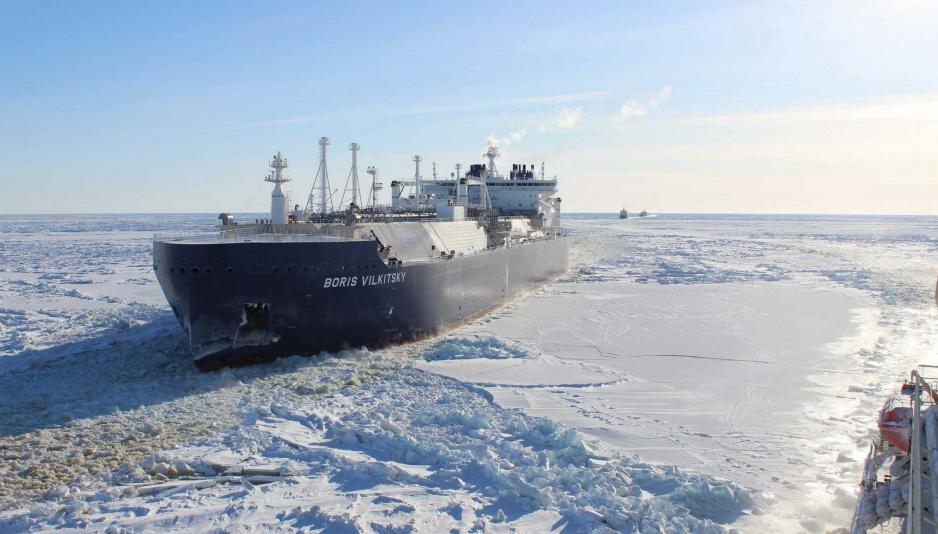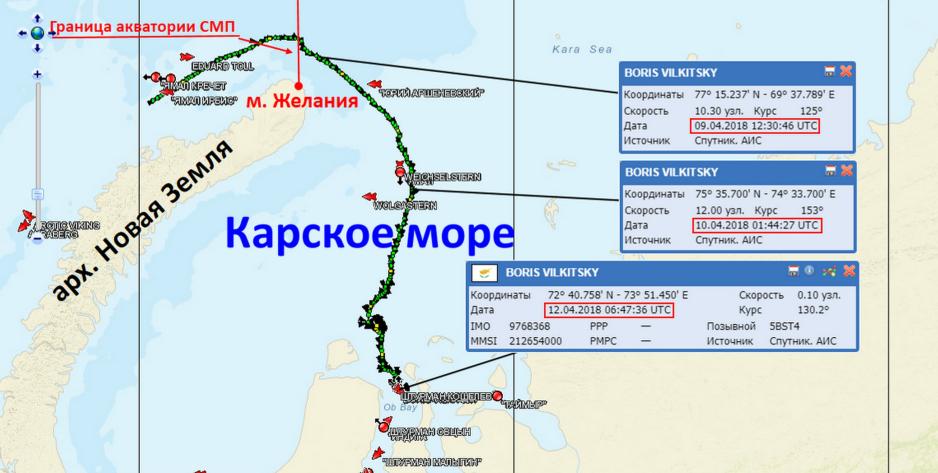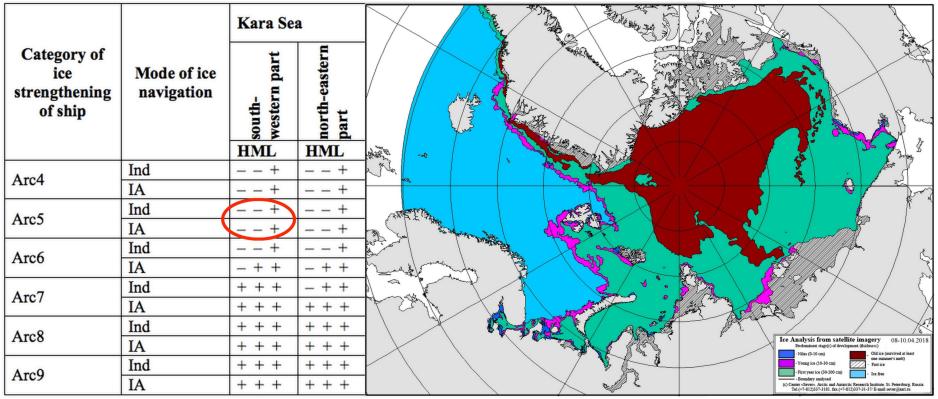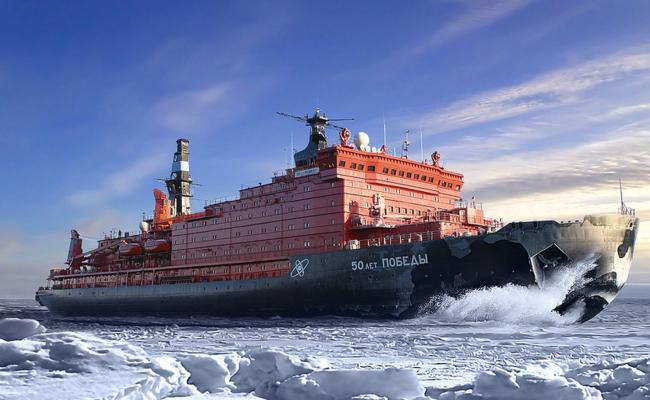Yamal LNG Carrier Boris Vilkitsky In Gross Violation of Safety Rules on NSR

The LNG Carrier Boris Vilkitsky, operated by Dynagas LNG Partners, a joint venture by Dynagas, Sinotrans, and China LNG Shipping, entered Northern Sea Route last week in violation of the Rules of Navigation. Safety concerns on the route abound in the light of nearly 100 violations in 2017 alone. Will Russian authorities act to ensure safety along the route?
The LNG carrier Boris Vilkitsky, a new ice-class vessel transporting natural gas from Russia’s Yamal LNG project, disregarded a number of safety rules on an Arctic voyage to the Port of Sabetta.
The vessel, operated by a Dynagas LNG Partners, a joint venture by Dynagas, Sinotrans, and China LNG Shipping, entered the Northern Sea Route (NSR) despite the inoperability of its stern thrusters and port steering column.
This malfunction, which occurred at least 10 days prior, limited the vessel’s capabilities and reduced its ice-classification from Arc7 to Arc4, prohibiting it from operating independently or even with an icebreaker escort in the waters of the Kara Sea. In violation of the rules the Boris Vilkitsky proceeded into the ice-covered waters of the NSR.
The Russian Northern Sea Route Administration (NSRA) calls the incident a gross violation of the Rules of Navigation in the waters of the NSR and states that “the vessel did not have the right to enter the water area of the Northern Sea Route. By its actions, the ship poses a threat to the safety of navigation, as well as the protection of the marine environment.”

Entering the Arctic despite malfunction
The Boris Vilkitsky is part of a fleet of 15 large, purpose-built LNG carriers. The vessels are operated by international shipping companies, including Dynagas, Teekay, China Shipping Development Company, and Mitsui O.S.K. Lines, under long-term charter contracts serving Novatek’s Yamal LNG project.
According to a report by Bureau Veritas, an international certification agency, the Boris Vilkitsky’s stern thruster and port steering column became inoperable on or before March 30th. As a result of this malfunction the vessel no longer met the minimum thrust requirements set forth by the Russian Maritime Register to be classified as an Arc7 vessel.
With the reduced engine power the vessel only met the requirements for the ice class Arc4. According to the NSR Administration’s Rules of Navigation Arc4 vessels are not permitted to operate in the south-western Kara Sea in medium or heavy ice conditions, even with icebreaker escort.
In clear violation of the law the Boris Vilkitsky entered the Kara Sea on April 9th encountering medium to heavy ice conditions with first-year ice up to 2 meters thick.
The ice conditions were known since at least March 23rd according to Roshydromet, Russia’s Federal Service for Hydrometeorology and Environmental Monitoring. Dynagas LNG Partners, the vessel’s operator, did not respond to multiple requests for comment regarding the incident.

Awaiting the Return Voyage
The vessel continued navigating in ice conditions for which it was not certified until April 12th when it arrived in the Port of Sabetta. It is currently unclear if the vessel took on a regular load of 170,000 cubic meters of LNG and will commence its return voyage again in breach of the Rules of Navigation.
The vessel departed from Sabetta on April 16th and is currently at anchor outside the port.
"To add insult to injury it looks like the vessel will make the return voyage. This looks like a typical gold rush mentality with little thought of risk both in the context of safety and the environment," says Dr. Simon Walmsley, Marine Manager of WWF International.
Lack of enforcement
The violation also raises questions about the NSRA’s ability to enforce the Rules of Navigation.
"If the Boris Vilkitsky is allowed to depart Sabetta without undergoing repairs, then it says a lot about either the political clout of the NSRA when challenging the gas industry, or the priority Moscow intends to give in this story," explains Prof. Frédéric Lasserre of the Université Laval Québec.
It seems the NSRA did not approve.
Indeed, for Moscow it appears more important to show reliable delivery of LNG even during winter months to strengthen investors’ interest in its Arctic projects, rather than admitting that operating in the waters of the NSR even with highly capable ice-class vessels remains a pioneer project.
In light of the fact that Novatek is currently searching for investors as far as Saudi Arabia and China to help finance its new Arctic LNG II project, it appears safety rules have to take a back seat to investment considerations.
"For the Boris Vilkitsky, it seems the NSRA did not approve, but lacks the teeth to enforce sanctions. Is a sinking necessary to ring more serious alarm bells?" asks Lasserre.
Boris Vilkitsky violated other NSR rules
In addition to operating in ice conditions for which the Boris Vilkitsky was not certified, the vessel’s crew violated Rule 19 of the Rules of Navigation. The crew failed to inform the NSRA of the time, coordinates, track, and speed of the vessel when it entered the waters of the NSR.
This is not the first time a vessel ignored this rule. In 2017 Rule 19 was the second most common violation on the route.
Also read
"This is exactly why we have international regulation such as the Polar Code and this is exactly why this and regional measures need to be implemented and enforced. If vessels are not adhering to the rules then they should not be permitted to operate," urges Walmsley.
The onus for enforcing rules also falls on the flag state, the country in which the vessel is registered. The Boris Vilkitsky is registered in Cyprus which boasts one of the lowest taxation rates in the European Union.
"The flag state needs to live up to its responsibility and ensure its vessels are operating within the rules, the port state needs to enforce this. All this needs to be undertaken before a major accident occurs," appeals Walmsley.
Pattern of Safety Violations on NSR
Some experts caution against drawing general conclusions about the safety of Russia’s Arctic operation from this single incident.
"I think one cannot draw implications for the broader issue of natural resources extraction based on this episode alone. But it is disturbing and one would expect a comprehensive explanation," says Arild Moe Senior Research Fellow at the Fridtjof Nansen Institute.
That violations of such nature are already occurring is of particular concern.
Nonetheless, the current incident isn’t the first time that vessels have ignored important safety rules. In 2017 the NSRA recorded nearly 100 violations, representing between 15-20 % of all ships traveling the route that year.
Similarly in both 2016 and 2015 Russian authorities noted in excess of 50 violations. It is unclear if the NSRA issues fines or other penalties to vessels violating shipping rules. In a statement to High North News the NSRA’s Head of the Shipping Department, Svyatoslav Stepchenkov, declined to confirm whether the Boris Vilkitsky would be facing any fines.
Self-regulation vs. better enforcement
Some experts express the hope that the industry will experience some kind of self-regulation moving away from unsafe shipping practices. "Yamal LNG is a pioneer project, and one would expect that lessons are learned for subsequent projects. Unsafe shipping can also become a liability for the oil companies involved, as they may risk damage to their reputation," explains Moe.
But others are more cautious on the sector’s ability to ensure that safety rules are being met without stronger oversight.
"The fact that violations of such nature are already occurring is of particular concern especially in a very harsh and sensitive area," cautions Walmsley.
"Enforcement needs to be improved asap before a significant accident occurs and before vessel traffic increases along with the risk."


